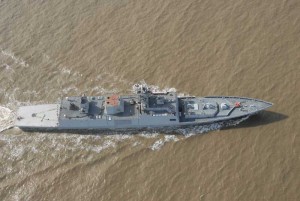The search for new means of propulsion at sea is driven as much by the rising cost, as by the environmental impact of our dwindling fossil fuel resources. Nuclear propulsion has its uses, but only in limited applications. With advances in materials such as permanent magnets and high temperature superconductors, the focus has now shifted to electric propulsion and many propulsion plants are already at sea, but mainly in the cruise liner business. The progress of electric propulsion is being watched with great interest, and the future certainly seems to lie in the “all electric ship”.
With modularity rapidly gaining acceptance, both as an economy measure and a force multiplier, platforms will become multi-role. Such designs would allow swapping of guns, weapon launchers, mine counter-measures gear or helicopter decks as required. Modular systems like the Danish STANFLEX are an idea whose time has at last come; and navies are being increasingly drawn towards it, as is obvious from the Littoral Combat Ship and “Streetfighter” under development for the US Navy.
The missile, torpedo and even the lowly mine continue to be an omnipresent threat to the naval combatant. Ship and submarine-launched cruise missiles, as well as shore based anti-ship missiles add to the complexity of maritime operations in the littoral. As smart weapon systems enter service, even smarter counter-measures are on offer, but budgetary constraints may not always permit navies to invest in them. Therefore, tactical acumen has to often substitute for technology at sea.
 The vast benefits of multimedia telecommunications have made it possible for fleets to have enhanced knowledge management. Not only is the operational domain becoming increasingly transparent but the need for distant units to share a common situational awareness amongst themselves and with the command ashore is driving the need for networking.
The vast benefits of multimedia telecommunications have made it possible for fleets to have enhanced knowledge management. Not only is the operational domain becoming increasingly transparent but the need for distant units to share a common situational awareness amongst themselves and with the command ashore is driving the need for networking.
Networking a navy is an undertaking as fraught with complexity as it is expensive in execution. The Indian Navy has however, taken the plunge and committed itself to networked operations before the end of the decade. In the context of regional maritime cooperation, there is no area more urgent than the establishment of communication channels and protocols that enable better coordination. Information Technology offers us a convenient means of linking friendly forces, and we also have a satellite launch capability in the region. Therefore, in the years ahead, we could perhaps look at a regional maritime data network. This would enable navies to cooperate effectively in areas such as SAR, pollution control, countering maritime terrorism and piracy, and of course, disaster relief operations.
Finally, warship building today is an expensive proposition due to the high infrastructure costs of shipyards, as well as the expense of design and development. Collaborative R&D, design, building and even marketing efforts between two or more countries in this region can bring with it many advantages, including economies of scale, amortization of development cost and simplification of logistic support.
Conclusion
As one contemplates the mechanics and implications of transformation at sea, it is easy to lose oneself in the marvels of technology. In all this, there is a need to retain clarity and focus, and to bear in mind that technology is only a means to an end.
Moreover, while exploring technology and exploiting it at sea, we must also try and leverage it to bring navies together. The sum of the parts is often greater than the whole, and with the tremendous resources, and human talent available, given the resurgent economies of our region, we can achieve a lot if we work together.
As we go about our business at sea, those of us in our respective navies must work assiduously to create synergies for mutual benefit. If the unfortunate tsunami episode had a bright side at all, it was to provide us a heartwarming glimpse into the extended family system of South and South-East Asia, where countries reach out in times of adversity.
In conclusion, I would like to reiterate that the imperatives of globalization and our growing dependence on sea resources will ensure that the 21st century is a Maritime Century. Navies, if they so choose, can become catalysts for peace, tranquility and stability in the Indian Ocean Region. In this endeavour, transformational technologies will be their handmaidens.




